Operations Management Analysis: Toyota's Productivity and Capacity
VerifiedAdded on 2021/02/21
|9
|1973
|35
Report
AI Summary
This report provides a comprehensive analysis of Toyota's operations management, focusing on key aspects such as productivity, capacity utilization, and lean production. It begins by defining and calculating productivity, using Toyota as a case study to illustrate its practical application. The report then delves into capacity utilization, examining how Toyota manages its production capacity and the factors influencing its efficiency. A significant portion of the analysis is dedicated to lean production, exploring its core components and how Toyota implements them to minimize waste and enhance product quality. Furthermore, the report examines the cost of holding stock and assesses Toyota's production process, particularly the just-in-time (JIT) approach. The JIT system is evaluated for its appropriateness in Toyota's business context, highlighting its benefits and underlying principles. Finally, the report concludes with recommendations for improving Toyota's production process, considering factors such as capacity sharing and labor productivity enhancement. The analysis draws on various academic sources and industry data to provide a well-rounded understanding of Toyota's operational strategies and their impact on its overall performance.
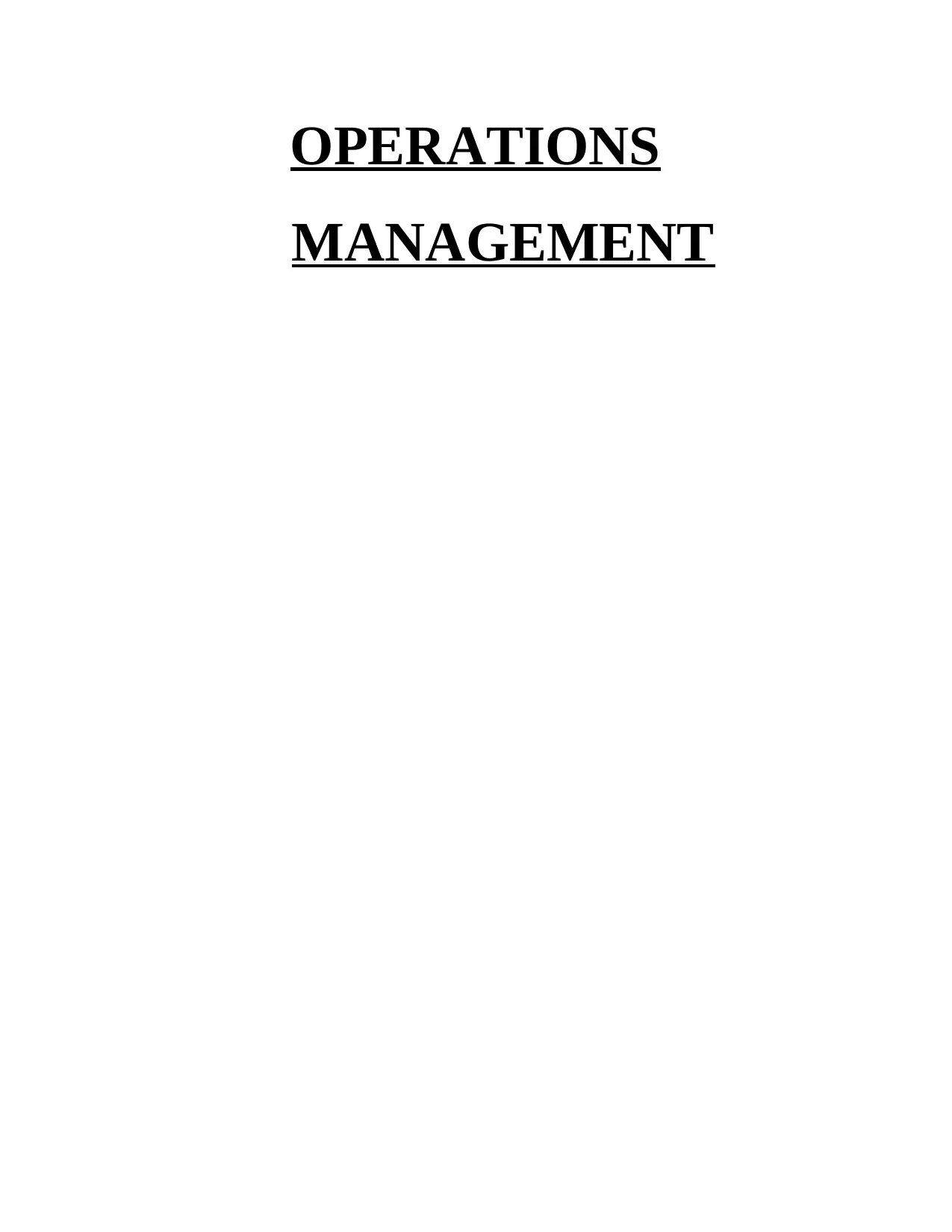
OPERATIONS
MANAGEMENT
MANAGEMENT
Paraphrase This Document
Need a fresh take? Get an instant paraphrase of this document with our AI Paraphraser
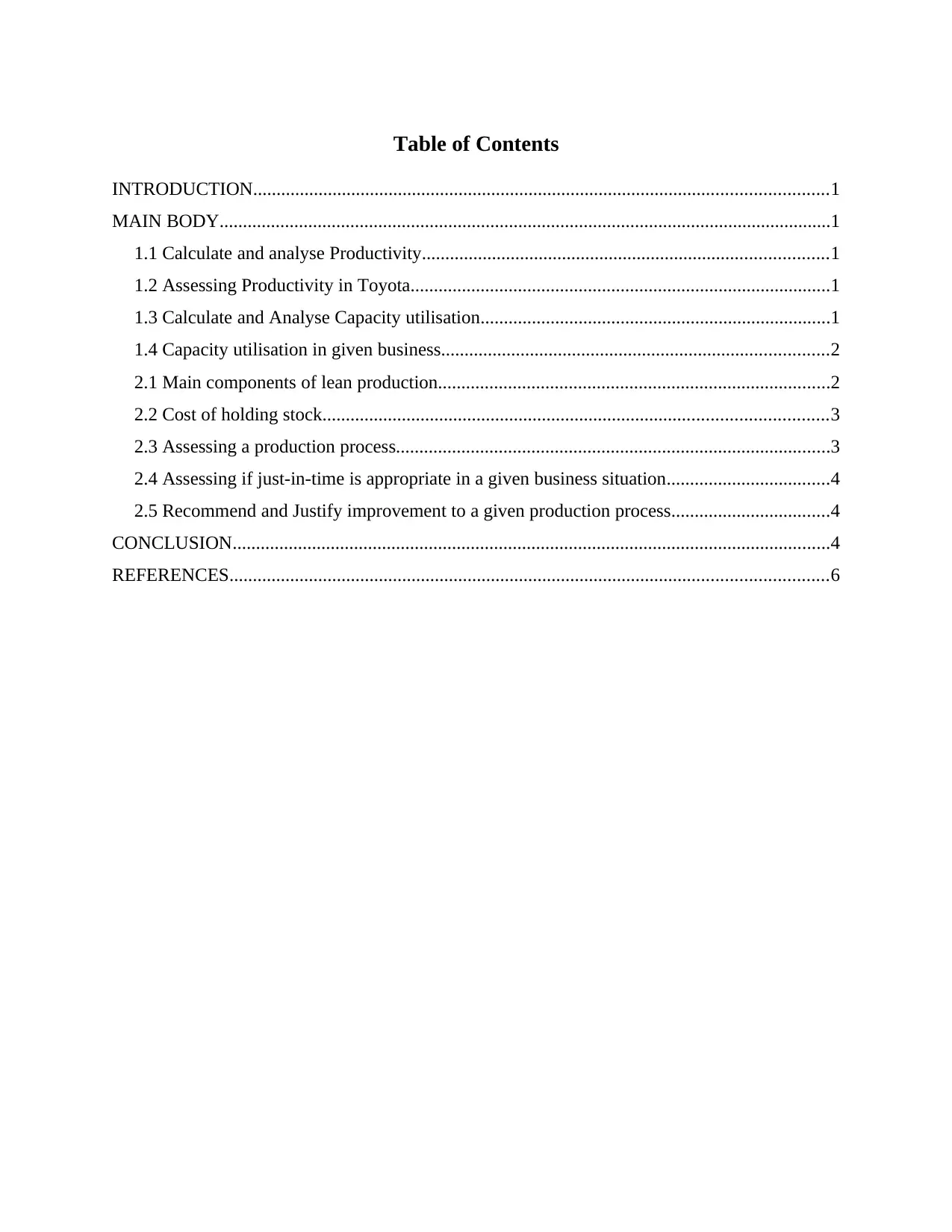
Table of Contents
INTRODUCTION...........................................................................................................................1
MAIN BODY...................................................................................................................................1
1.1 Calculate and analyse Productivity.......................................................................................1
1.2 Assessing Productivity in Toyota..........................................................................................1
1.3 Calculate and Analyse Capacity utilisation...........................................................................1
1.4 Capacity utilisation in given business...................................................................................2
2.1 Main components of lean production....................................................................................2
2.2 Cost of holding stock............................................................................................................3
2.3 Assessing a production process.............................................................................................3
2.4 Assessing if just-in-time is appropriate in a given business situation...................................4
2.5 Recommend and Justify improvement to a given production process..................................4
CONCLUSION................................................................................................................................4
REFERENCES................................................................................................................................6
INTRODUCTION...........................................................................................................................1
MAIN BODY...................................................................................................................................1
1.1 Calculate and analyse Productivity.......................................................................................1
1.2 Assessing Productivity in Toyota..........................................................................................1
1.3 Calculate and Analyse Capacity utilisation...........................................................................1
1.4 Capacity utilisation in given business...................................................................................2
2.1 Main components of lean production....................................................................................2
2.2 Cost of holding stock............................................................................................................3
2.3 Assessing a production process.............................................................................................3
2.4 Assessing if just-in-time is appropriate in a given business situation...................................4
2.5 Recommend and Justify improvement to a given production process..................................4
CONCLUSION................................................................................................................................4
REFERENCES................................................................................................................................6

⊘ This is a preview!⊘
Do you want full access?
Subscribe today to unlock all pages.

Trusted by 1+ million students worldwide
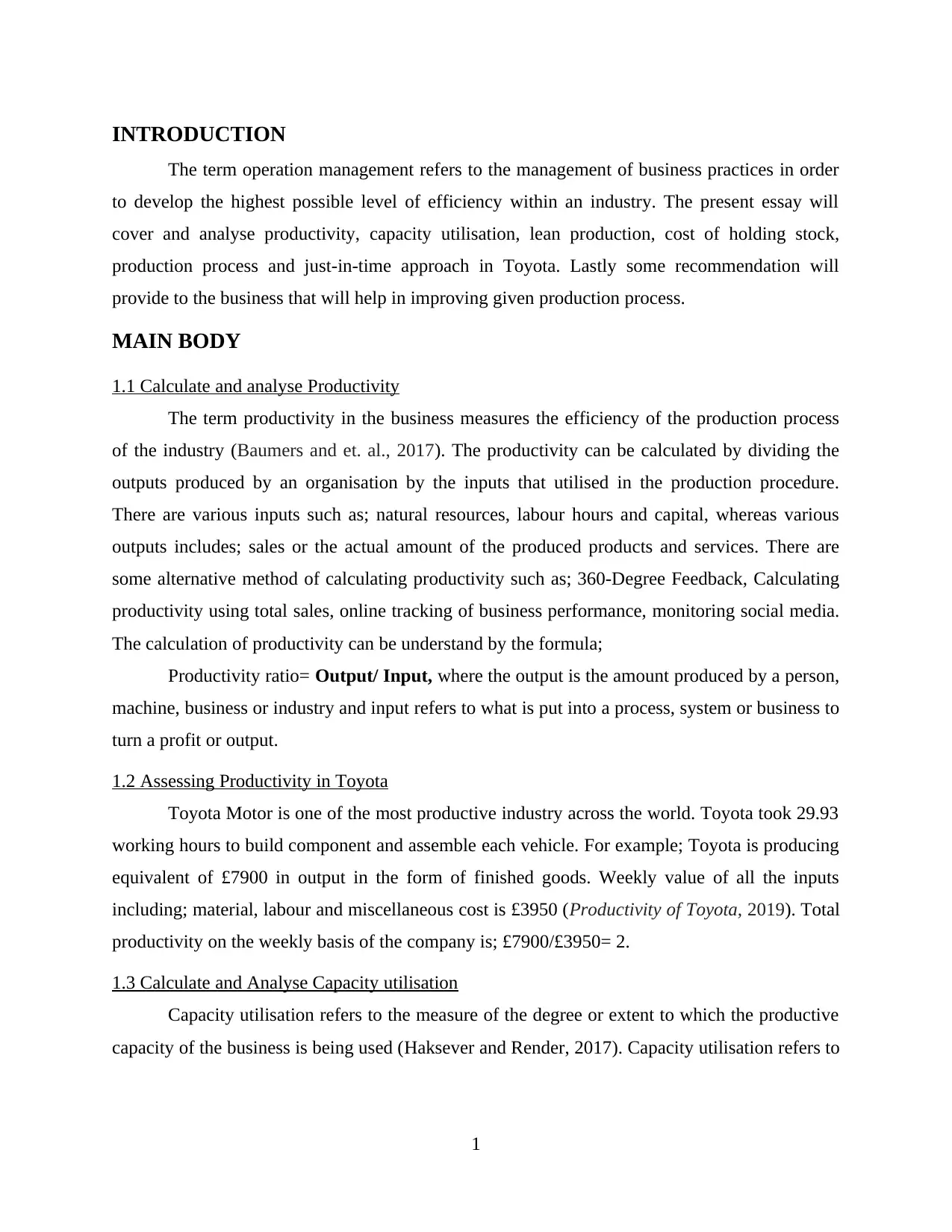
INTRODUCTION
The term operation management refers to the management of business practices in order
to develop the highest possible level of efficiency within an industry. The present essay will
cover and analyse productivity, capacity utilisation, lean production, cost of holding stock,
production process and just-in-time approach in Toyota. Lastly some recommendation will
provide to the business that will help in improving given production process.
MAIN BODY
1.1 Calculate and analyse Productivity
The term productivity in the business measures the efficiency of the production process
of the industry (Baumers and et. al., 2017). The productivity can be calculated by dividing the
outputs produced by an organisation by the inputs that utilised in the production procedure.
There are various inputs such as; natural resources, labour hours and capital, whereas various
outputs includes; sales or the actual amount of the produced products and services. There are
some alternative method of calculating productivity such as; 360-Degree Feedback, Calculating
productivity using total sales, online tracking of business performance, monitoring social media.
The calculation of productivity can be understand by the formula;
Productivity ratio= Output/ Input, where the output is the amount produced by a person,
machine, business or industry and input refers to what is put into a process, system or business to
turn a profit or output.
1.2 Assessing Productivity in Toyota
Toyota Motor is one of the most productive industry across the world. Toyota took 29.93
working hours to build component and assemble each vehicle. For example; Toyota is producing
equivalent of £7900 in output in the form of finished goods. Weekly value of all the inputs
including; material, labour and miscellaneous cost is £3950 (Productivity of Toyota, 2019). Total
productivity on the weekly basis of the company is; £7900/£3950= 2.
1.3 Calculate and Analyse Capacity utilisation
Capacity utilisation refers to the measure of the degree or extent to which the productive
capacity of the business is being used (Haksever and Render, 2017). Capacity utilisation refers to
1
The term operation management refers to the management of business practices in order
to develop the highest possible level of efficiency within an industry. The present essay will
cover and analyse productivity, capacity utilisation, lean production, cost of holding stock,
production process and just-in-time approach in Toyota. Lastly some recommendation will
provide to the business that will help in improving given production process.
MAIN BODY
1.1 Calculate and analyse Productivity
The term productivity in the business measures the efficiency of the production process
of the industry (Baumers and et. al., 2017). The productivity can be calculated by dividing the
outputs produced by an organisation by the inputs that utilised in the production procedure.
There are various inputs such as; natural resources, labour hours and capital, whereas various
outputs includes; sales or the actual amount of the produced products and services. There are
some alternative method of calculating productivity such as; 360-Degree Feedback, Calculating
productivity using total sales, online tracking of business performance, monitoring social media.
The calculation of productivity can be understand by the formula;
Productivity ratio= Output/ Input, where the output is the amount produced by a person,
machine, business or industry and input refers to what is put into a process, system or business to
turn a profit or output.
1.2 Assessing Productivity in Toyota
Toyota Motor is one of the most productive industry across the world. Toyota took 29.93
working hours to build component and assemble each vehicle. For example; Toyota is producing
equivalent of £7900 in output in the form of finished goods. Weekly value of all the inputs
including; material, labour and miscellaneous cost is £3950 (Productivity of Toyota, 2019). Total
productivity on the weekly basis of the company is; £7900/£3950= 2.
1.3 Calculate and Analyse Capacity utilisation
Capacity utilisation refers to the measure of the degree or extent to which the productive
capacity of the business is being used (Haksever and Render, 2017). Capacity utilisation refers to
1
Paraphrase This Document
Need a fresh take? Get an instant paraphrase of this document with our AI Paraphraser
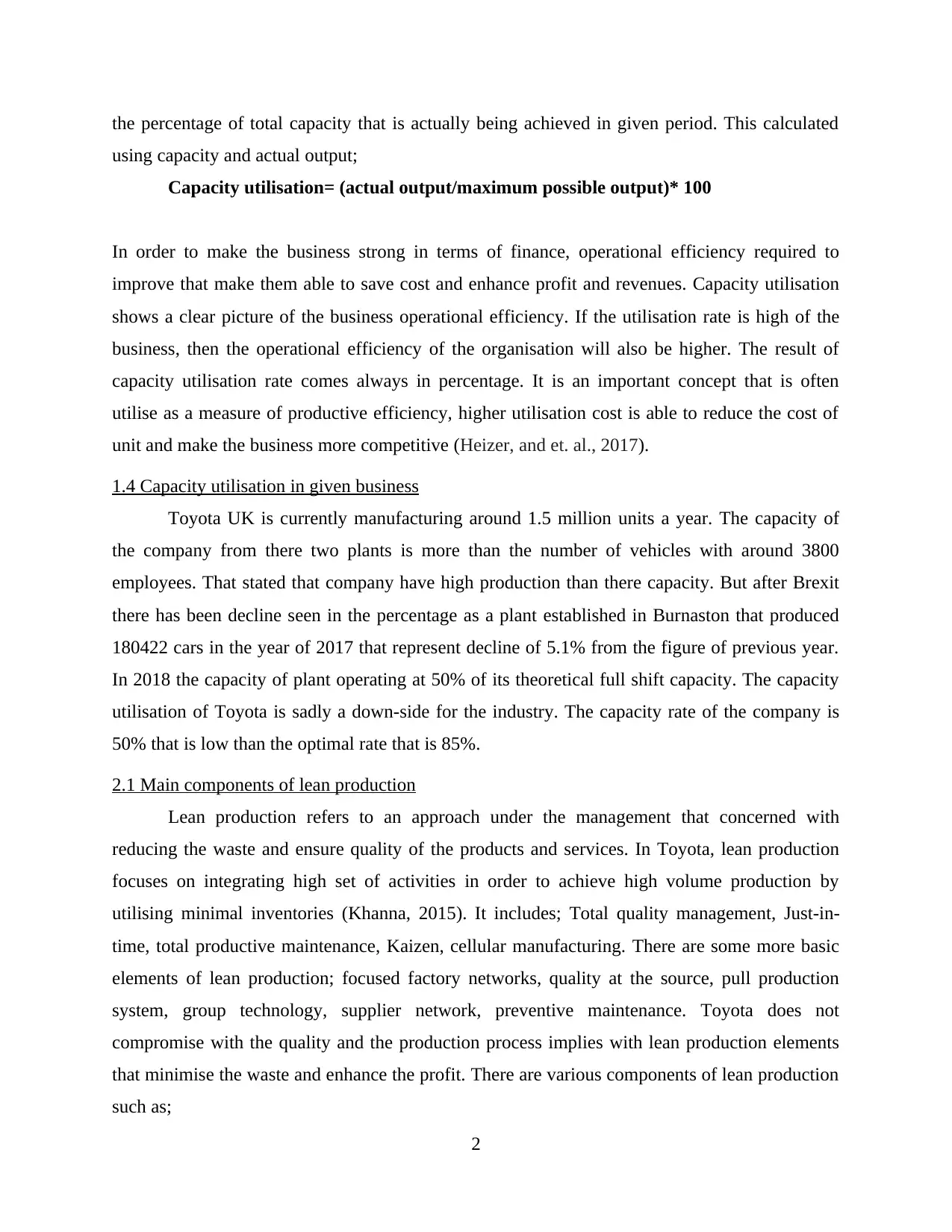
the percentage of total capacity that is actually being achieved in given period. This calculated
using capacity and actual output;
Capacity utilisation= (actual output/maximum possible output)* 100
In order to make the business strong in terms of finance, operational efficiency required to
improve that make them able to save cost and enhance profit and revenues. Capacity utilisation
shows a clear picture of the business operational efficiency. If the utilisation rate is high of the
business, then the operational efficiency of the organisation will also be higher. The result of
capacity utilisation rate comes always in percentage. It is an important concept that is often
utilise as a measure of productive efficiency, higher utilisation cost is able to reduce the cost of
unit and make the business more competitive (Heizer, and et. al., 2017).
1.4 Capacity utilisation in given business
Toyota UK is currently manufacturing around 1.5 million units a year. The capacity of
the company from there two plants is more than the number of vehicles with around 3800
employees. That stated that company have high production than there capacity. But after Brexit
there has been decline seen in the percentage as a plant established in Burnaston that produced
180422 cars in the year of 2017 that represent decline of 5.1% from the figure of previous year.
In 2018 the capacity of plant operating at 50% of its theoretical full shift capacity. The capacity
utilisation of Toyota is sadly a down-side for the industry. The capacity rate of the company is
50% that is low than the optimal rate that is 85%.
2.1 Main components of lean production
Lean production refers to an approach under the management that concerned with
reducing the waste and ensure quality of the products and services. In Toyota, lean production
focuses on integrating high set of activities in order to achieve high volume production by
utilising minimal inventories (Khanna, 2015). It includes; Total quality management, Just-in-
time, total productive maintenance, Kaizen, cellular manufacturing. There are some more basic
elements of lean production; focused factory networks, quality at the source, pull production
system, group technology, supplier network, preventive maintenance. Toyota does not
compromise with the quality and the production process implies with lean production elements
that minimise the waste and enhance the profit. There are various components of lean production
such as;
2
using capacity and actual output;
Capacity utilisation= (actual output/maximum possible output)* 100
In order to make the business strong in terms of finance, operational efficiency required to
improve that make them able to save cost and enhance profit and revenues. Capacity utilisation
shows a clear picture of the business operational efficiency. If the utilisation rate is high of the
business, then the operational efficiency of the organisation will also be higher. The result of
capacity utilisation rate comes always in percentage. It is an important concept that is often
utilise as a measure of productive efficiency, higher utilisation cost is able to reduce the cost of
unit and make the business more competitive (Heizer, and et. al., 2017).
1.4 Capacity utilisation in given business
Toyota UK is currently manufacturing around 1.5 million units a year. The capacity of
the company from there two plants is more than the number of vehicles with around 3800
employees. That stated that company have high production than there capacity. But after Brexit
there has been decline seen in the percentage as a plant established in Burnaston that produced
180422 cars in the year of 2017 that represent decline of 5.1% from the figure of previous year.
In 2018 the capacity of plant operating at 50% of its theoretical full shift capacity. The capacity
utilisation of Toyota is sadly a down-side for the industry. The capacity rate of the company is
50% that is low than the optimal rate that is 85%.
2.1 Main components of lean production
Lean production refers to an approach under the management that concerned with
reducing the waste and ensure quality of the products and services. In Toyota, lean production
focuses on integrating high set of activities in order to achieve high volume production by
utilising minimal inventories (Khanna, 2015). It includes; Total quality management, Just-in-
time, total productive maintenance, Kaizen, cellular manufacturing. There are some more basic
elements of lean production; focused factory networks, quality at the source, pull production
system, group technology, supplier network, preventive maintenance. Toyota does not
compromise with the quality and the production process implies with lean production elements
that minimise the waste and enhance the profit. There are various components of lean production
such as;
2
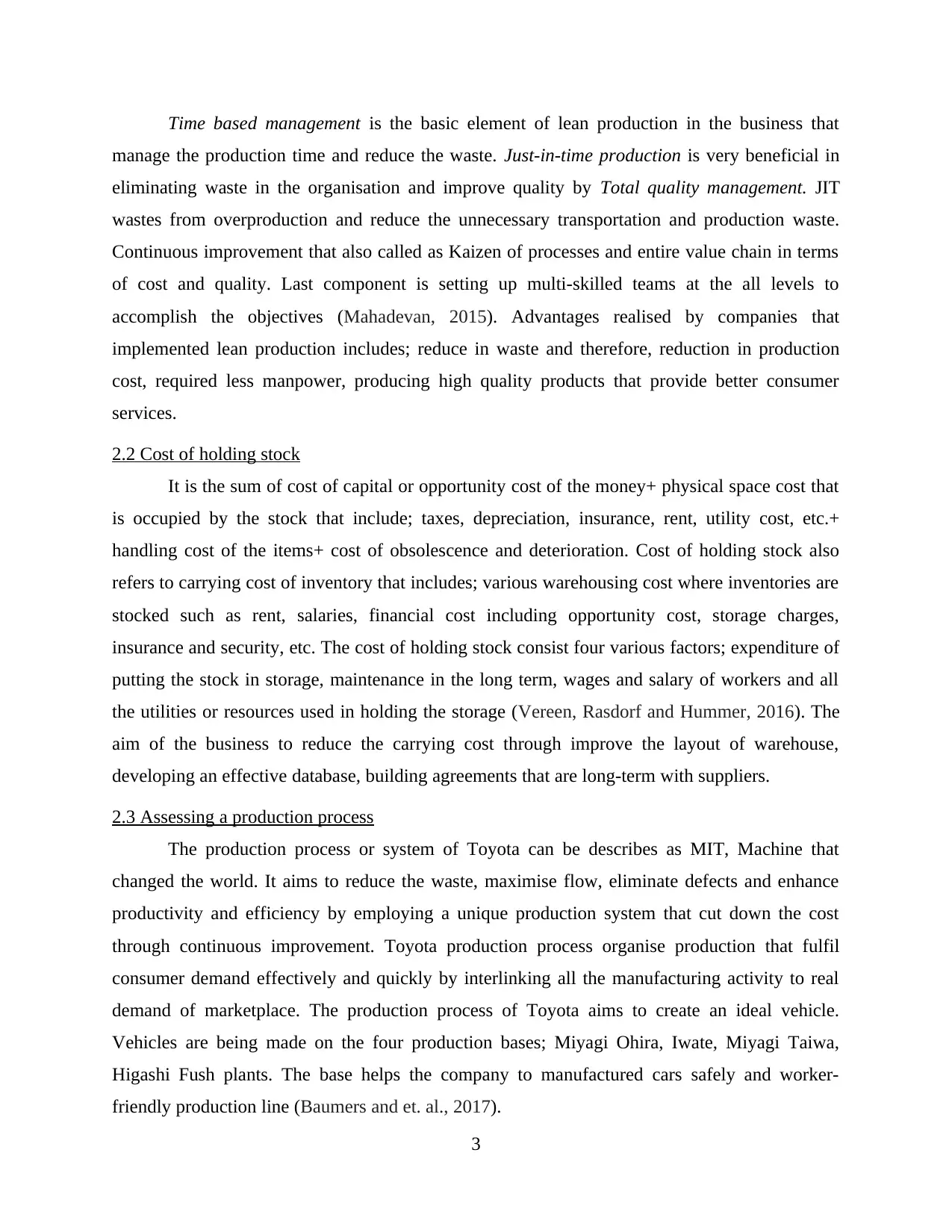
Time based management is the basic element of lean production in the business that
manage the production time and reduce the waste. Just-in-time production is very beneficial in
eliminating waste in the organisation and improve quality by Total quality management. JIT
wastes from overproduction and reduce the unnecessary transportation and production waste.
Continuous improvement that also called as Kaizen of processes and entire value chain in terms
of cost and quality. Last component is setting up multi-skilled teams at the all levels to
accomplish the objectives (Mahadevan, 2015). Advantages realised by companies that
implemented lean production includes; reduce in waste and therefore, reduction in production
cost, required less manpower, producing high quality products that provide better consumer
services.
2.2 Cost of holding stock
It is the sum of cost of capital or opportunity cost of the money+ physical space cost that
is occupied by the stock that include; taxes, depreciation, insurance, rent, utility cost, etc.+
handling cost of the items+ cost of obsolescence and deterioration. Cost of holding stock also
refers to carrying cost of inventory that includes; various warehousing cost where inventories are
stocked such as rent, salaries, financial cost including opportunity cost, storage charges,
insurance and security, etc. The cost of holding stock consist four various factors; expenditure of
putting the stock in storage, maintenance in the long term, wages and salary of workers and all
the utilities or resources used in holding the storage (Vereen, Rasdorf and Hummer, 2016). The
aim of the business to reduce the carrying cost through improve the layout of warehouse,
developing an effective database, building agreements that are long-term with suppliers.
2.3 Assessing a production process
The production process or system of Toyota can be describes as MIT, Machine that
changed the world. It aims to reduce the waste, maximise flow, eliminate defects and enhance
productivity and efficiency by employing a unique production system that cut down the cost
through continuous improvement. Toyota production process organise production that fulfil
consumer demand effectively and quickly by interlinking all the manufacturing activity to real
demand of marketplace. The production process of Toyota aims to create an ideal vehicle.
Vehicles are being made on the four production bases; Miyagi Ohira, Iwate, Miyagi Taiwa,
Higashi Fush plants. The base helps the company to manufactured cars safely and worker-
friendly production line (Baumers and et. al., 2017).
3
manage the production time and reduce the waste. Just-in-time production is very beneficial in
eliminating waste in the organisation and improve quality by Total quality management. JIT
wastes from overproduction and reduce the unnecessary transportation and production waste.
Continuous improvement that also called as Kaizen of processes and entire value chain in terms
of cost and quality. Last component is setting up multi-skilled teams at the all levels to
accomplish the objectives (Mahadevan, 2015). Advantages realised by companies that
implemented lean production includes; reduce in waste and therefore, reduction in production
cost, required less manpower, producing high quality products that provide better consumer
services.
2.2 Cost of holding stock
It is the sum of cost of capital or opportunity cost of the money+ physical space cost that
is occupied by the stock that include; taxes, depreciation, insurance, rent, utility cost, etc.+
handling cost of the items+ cost of obsolescence and deterioration. Cost of holding stock also
refers to carrying cost of inventory that includes; various warehousing cost where inventories are
stocked such as rent, salaries, financial cost including opportunity cost, storage charges,
insurance and security, etc. The cost of holding stock consist four various factors; expenditure of
putting the stock in storage, maintenance in the long term, wages and salary of workers and all
the utilities or resources used in holding the storage (Vereen, Rasdorf and Hummer, 2016). The
aim of the business to reduce the carrying cost through improve the layout of warehouse,
developing an effective database, building agreements that are long-term with suppliers.
2.3 Assessing a production process
The production process or system of Toyota can be describes as MIT, Machine that
changed the world. It aims to reduce the waste, maximise flow, eliminate defects and enhance
productivity and efficiency by employing a unique production system that cut down the cost
through continuous improvement. Toyota production process organise production that fulfil
consumer demand effectively and quickly by interlinking all the manufacturing activity to real
demand of marketplace. The production process of Toyota aims to create an ideal vehicle.
Vehicles are being made on the four production bases; Miyagi Ohira, Iwate, Miyagi Taiwa,
Higashi Fush plants. The base helps the company to manufactured cars safely and worker-
friendly production line (Baumers and et. al., 2017).
3
⊘ This is a preview!⊘
Do you want full access?
Subscribe today to unlock all pages.

Trusted by 1+ million students worldwide
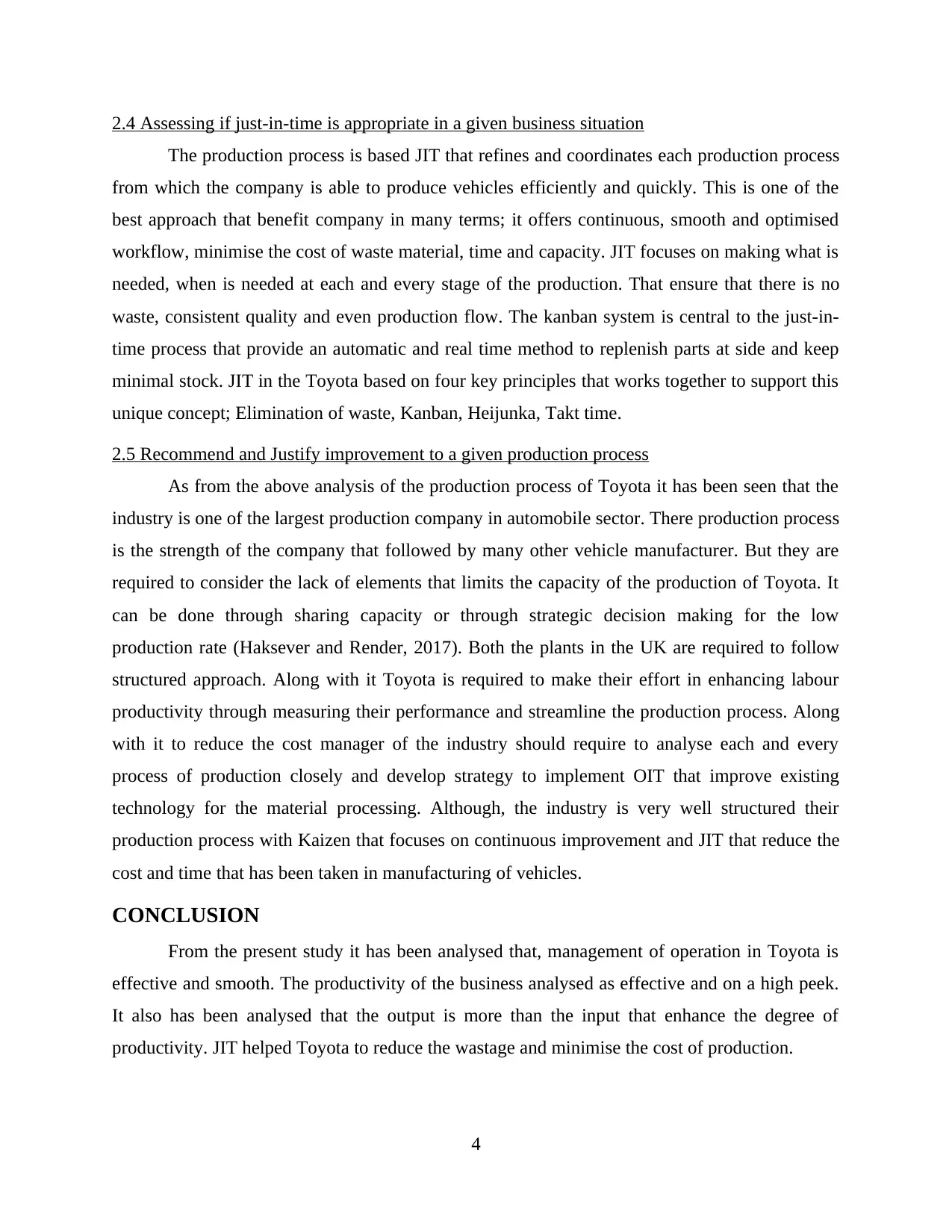
2.4 Assessing if just-in-time is appropriate in a given business situation
The production process is based JIT that refines and coordinates each production process
from which the company is able to produce vehicles efficiently and quickly. This is one of the
best approach that benefit company in many terms; it offers continuous, smooth and optimised
workflow, minimise the cost of waste material, time and capacity. JIT focuses on making what is
needed, when is needed at each and every stage of the production. That ensure that there is no
waste, consistent quality and even production flow. The kanban system is central to the just-in-
time process that provide an automatic and real time method to replenish parts at side and keep
minimal stock. JIT in the Toyota based on four key principles that works together to support this
unique concept; Elimination of waste, Kanban, Heijunka, Takt time.
2.5 Recommend and Justify improvement to a given production process
As from the above analysis of the production process of Toyota it has been seen that the
industry is one of the largest production company in automobile sector. There production process
is the strength of the company that followed by many other vehicle manufacturer. But they are
required to consider the lack of elements that limits the capacity of the production of Toyota. It
can be done through sharing capacity or through strategic decision making for the low
production rate (Haksever and Render, 2017). Both the plants in the UK are required to follow
structured approach. Along with it Toyota is required to make their effort in enhancing labour
productivity through measuring their performance and streamline the production process. Along
with it to reduce the cost manager of the industry should require to analyse each and every
process of production closely and develop strategy to implement OIT that improve existing
technology for the material processing. Although, the industry is very well structured their
production process with Kaizen that focuses on continuous improvement and JIT that reduce the
cost and time that has been taken in manufacturing of vehicles.
CONCLUSION
From the present study it has been analysed that, management of operation in Toyota is
effective and smooth. The productivity of the business analysed as effective and on a high peek.
It also has been analysed that the output is more than the input that enhance the degree of
productivity. JIT helped Toyota to reduce the wastage and minimise the cost of production.
4
The production process is based JIT that refines and coordinates each production process
from which the company is able to produce vehicles efficiently and quickly. This is one of the
best approach that benefit company in many terms; it offers continuous, smooth and optimised
workflow, minimise the cost of waste material, time and capacity. JIT focuses on making what is
needed, when is needed at each and every stage of the production. That ensure that there is no
waste, consistent quality and even production flow. The kanban system is central to the just-in-
time process that provide an automatic and real time method to replenish parts at side and keep
minimal stock. JIT in the Toyota based on four key principles that works together to support this
unique concept; Elimination of waste, Kanban, Heijunka, Takt time.
2.5 Recommend and Justify improvement to a given production process
As from the above analysis of the production process of Toyota it has been seen that the
industry is one of the largest production company in automobile sector. There production process
is the strength of the company that followed by many other vehicle manufacturer. But they are
required to consider the lack of elements that limits the capacity of the production of Toyota. It
can be done through sharing capacity or through strategic decision making for the low
production rate (Haksever and Render, 2017). Both the plants in the UK are required to follow
structured approach. Along with it Toyota is required to make their effort in enhancing labour
productivity through measuring their performance and streamline the production process. Along
with it to reduce the cost manager of the industry should require to analyse each and every
process of production closely and develop strategy to implement OIT that improve existing
technology for the material processing. Although, the industry is very well structured their
production process with Kaizen that focuses on continuous improvement and JIT that reduce the
cost and time that has been taken in manufacturing of vehicles.
CONCLUSION
From the present study it has been analysed that, management of operation in Toyota is
effective and smooth. The productivity of the business analysed as effective and on a high peek.
It also has been analysed that the output is more than the input that enhance the degree of
productivity. JIT helped Toyota to reduce the wastage and minimise the cost of production.
4
Paraphrase This Document
Need a fresh take? Get an instant paraphrase of this document with our AI Paraphraser

5
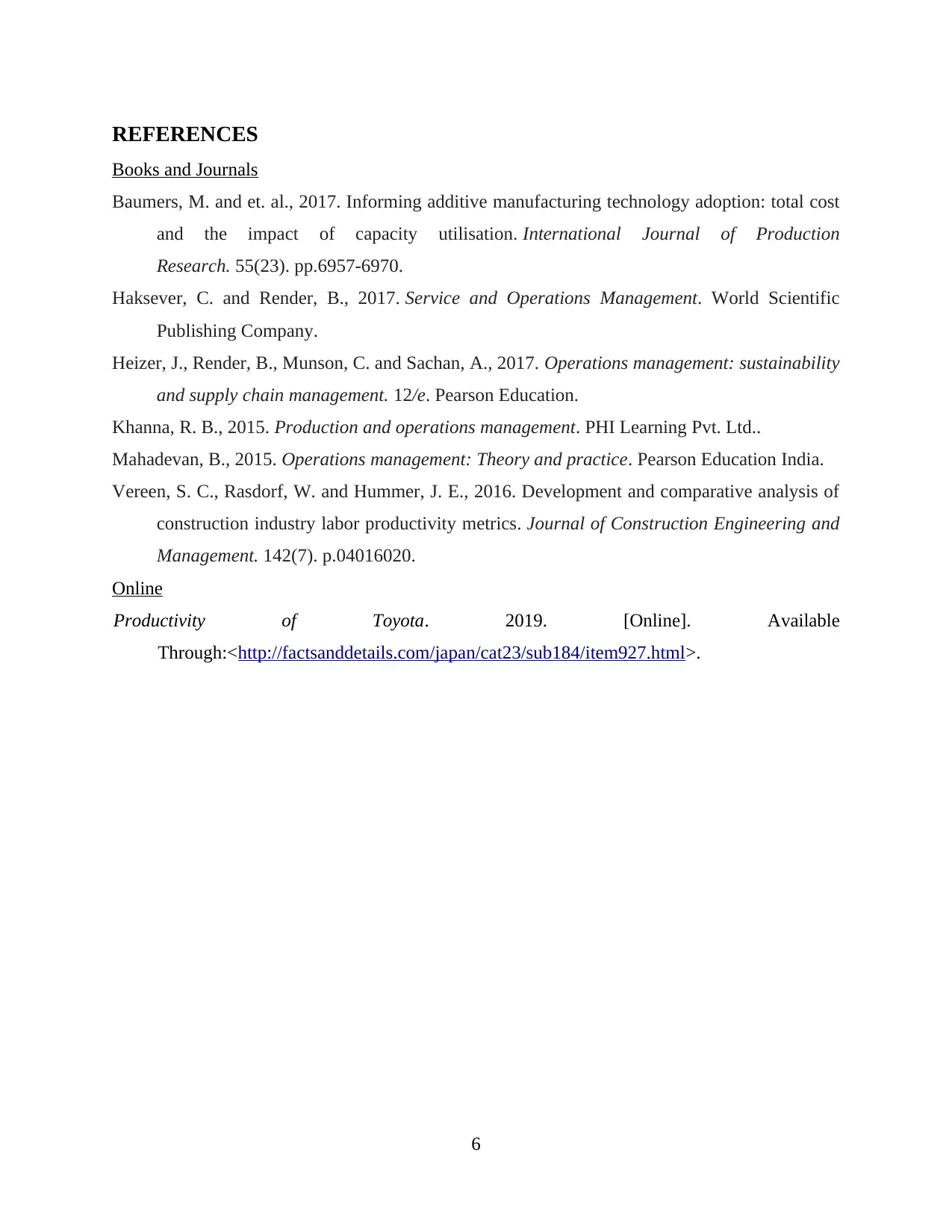
REFERENCES
Books and Journals
Baumers, M. and et. al., 2017. Informing additive manufacturing technology adoption: total cost
and the impact of capacity utilisation. International Journal of Production
Research. 55(23). pp.6957-6970.
Haksever, C. and Render, B., 2017. Service and Operations Management. World Scientific
Publishing Company.
Heizer, J., Render, B., Munson, C. and Sachan, A., 2017. Operations management: sustainability
and supply chain management. 12/e. Pearson Education.
Khanna, R. B., 2015. Production and operations management. PHI Learning Pvt. Ltd..
Mahadevan, B., 2015. Operations management: Theory and practice. Pearson Education India.
Vereen, S. C., Rasdorf, W. and Hummer, J. E., 2016. Development and comparative analysis of
construction industry labor productivity metrics. Journal of Construction Engineering and
Management. 142(7). p.04016020.
Online
Productivity of Toyota. 2019. [Online]. Available
Through:<http://factsanddetails.com/japan/cat23/sub184/item927.html>.
6
Books and Journals
Baumers, M. and et. al., 2017. Informing additive manufacturing technology adoption: total cost
and the impact of capacity utilisation. International Journal of Production
Research. 55(23). pp.6957-6970.
Haksever, C. and Render, B., 2017. Service and Operations Management. World Scientific
Publishing Company.
Heizer, J., Render, B., Munson, C. and Sachan, A., 2017. Operations management: sustainability
and supply chain management. 12/e. Pearson Education.
Khanna, R. B., 2015. Production and operations management. PHI Learning Pvt. Ltd..
Mahadevan, B., 2015. Operations management: Theory and practice. Pearson Education India.
Vereen, S. C., Rasdorf, W. and Hummer, J. E., 2016. Development and comparative analysis of
construction industry labor productivity metrics. Journal of Construction Engineering and
Management. 142(7). p.04016020.
Online
Productivity of Toyota. 2019. [Online]. Available
Through:<http://factsanddetails.com/japan/cat23/sub184/item927.html>.
6
⊘ This is a preview!⊘
Do you want full access?
Subscribe today to unlock all pages.

Trusted by 1+ million students worldwide
1 out of 9
Related Documents
Your All-in-One AI-Powered Toolkit for Academic Success.
+13062052269
info@desklib.com
Available 24*7 on WhatsApp / Email
![[object Object]](/_next/static/media/star-bottom.7253800d.svg)
Unlock your academic potential
Copyright © 2020–2025 A2Z Services. All Rights Reserved. Developed and managed by ZUCOL.




